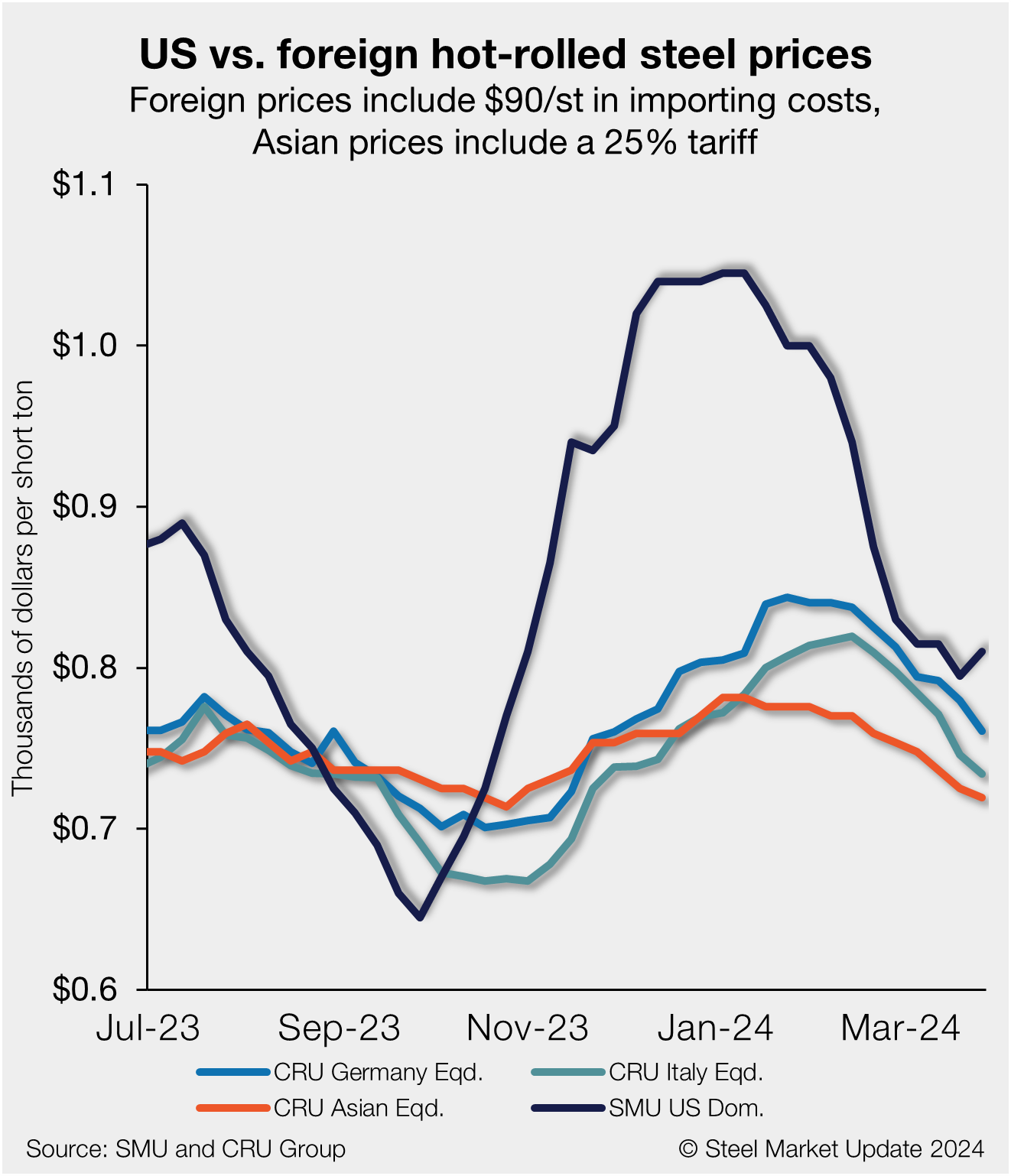Steel Products Prices North America

Steel Prices: Nowhere to Go But Up?
Written by Tim Triplett
February 14, 2019
Steel prices are trying to rise following the $40 per ton increase announced by the mills last month, but how fast, how far and for how long remains the subject of much speculation. Comments from SMU’s market canvas this week show buyers with two basic views: Either, “Mills are very firm on pricing. We’ve got nowhere to go but up.” Or, “I expect prices to be stable for a few weeks and then continue to drop.”
Steel Market Update has had our Price Momentum Indicator at Neutral since Nucor announced the $40 per ton flat rolled increase. As we speak with steel buyers we are hearing that the low-end offers are drying up. In other words, the sub-$660 hot rolled, and sub-$39.00/cwt base cold rolled and coated base price offers are no longer easily available. One hot rolled buyer told us yesterday that the mills are asking for a “firm” $700 per ton. However, when actual orders are being discussed, the numbers can go to $680 for relatively modest tons. We are being told to expect another price increase in the $20 to $40 per ton range as a way for the mills to cement in the full $40 recently announced and bring that bottom line number up to $700-$720 per ton on HRC.
SMU believes we have reached a near-term bottom, and we could see some tightening of the spread as the lower offers are eliminated and mill order books improve. We are going to continue to keep our Price Momentum Indicator at Neutral. This means prices could bounce from here and that there is no clear-cut direction to the market. To illustrate the back and forth we have seen amongst steel buyers, the following quotes were provided to SMU as we canvassed the market to collect pricing data earlier this week:
Following is a sampling of observations from those who anticipate a sustained increase in prices:
“Lead times are steady, galvanized is out a little. The mills are holding so far. Prices could move up again before the end of February.”
“Lead times are running into late March for hot rolled to the middle of April for galvanized. Mills have moved prices up a bit from the bottom. It was $38 for volume, now it’s $39. We’re still expecting upward movement. All the numbers on foreign that I’m seeing have moved up to $39.75 and more.”
“Lead times on HR are 3-6 weeks depending on the mill. Most mills are not dropping below $33/34. Steel prices are stabilizing for now.”
“Lead times on flat rolled have firmed up and maybe extended by a week. Mills are still negotiating on pricing, but not as aggressively. Certainly, they are holding the bottom. Flat rolled pricing is likely to creep upward slightly as the bottom firms up and service centers return to a more normal buying pattern. Plate is still extremely suspect as everyone awaits to see how demand continues, including pipe jobs.”
“We’re seeing some extension on lead times for most products. We’re hearing lots of activity on the line pipe front that could affect hot rolled lead times, especially down South, very soon. The bottom in pricing has definitely moved up. There’s always room for some negotiation, but nowhere near as much as a couple of weeks ago. Steel prices from here depend on import levels in Jan./Feb./March. If they drop materially, this thing [increase] could gain legs. Otherwise we are stuck.”
“Lead times have extended on galvanized, either on an inquire basis or for April delivery. The mills are only getting half the increase. Prices will be flat or up from here.”
“It appears the HRC lead time is moving out a bit since the price announcements. We are looking at mid-March with most of the steel mills. The mills are pushing for $700 base for HRC, but are still open to limited negotiations on prices. Global factors including the Vale dam accident, weather and politics/tariffs will provide support for domestic prices to rise a bit in the next 30-60 days.”
Following is a sampling of observations from those who question the staying power of the price increases:
“Mills are a little firmer on coated. As the lead times move out a little, I would expect all flat rolled products to move upward, but don’t think we will see a repeat of last year’s escalation. I’d expect pricing to firm for the next two or three months, but within a fairly narrow range as imports will create a top to the range.”
“From what I am hearing through my steel suppliers, the price increase stopped the slide, but mills are still negotiating. I expect prices to be stable for a few weeks and then continue to drop.”
“We’ve seen some extensions in lead times, up one to two weeks from the lows, but it’s not uniform by company or geography. Mills are trying to hold the line, but admitting it’s about a two-week exercise, meaning if they don’t book enough to get a clear cushion, they’re prepared to pull back from the minimums. By doing this, they’re clearly signaling that they don’t want to lose an order and that volume remains a higher priority than price. A big reason for this is that they’re still enjoying healthy margins at recent price levels. A company faced with low/no margins has a much higher focus on price. We expect steel prices to move more or less sideways for a few weeks, and then other factors will likely emerge to affect prices. For example, the Vale accident, and the fallout from the same, remains a wildcard with the potential to upend the global market. Future import trends could have a supply impact by spring/summer, if they move lower and stay lower.”
“Lead times [on plate] have not extended. They range from 4-8 for base gauge sizes. Plate pricing could drift slowly down as we go through Q2. It really depends on the OEM and project demand the mills have. I could draw up a scenario that says prices stay stable through Q2 and start to drop in Q3.”
“Galv has extended slightly; in HRC we see no change. We see a willingness by the mills to negotiate on large tonnage quotes. We see less wiggle-room on small inquiries. I think the mills have captured a small portion of the increase. However, I think this will fade fast and the market goes lower again in the coming weeks.”
“Lead times are starting to push out on galv and HR, though there is some concern that published lead times are not matching up. Two mills in the South have some availability in February for HR, but published lead times say March. Mill reps are trying to hold the line, but still trying to push HR lead times out, so they are negotiating some. They are getting some of the increase.”
“Excess capacity is a concern with more coming online in the U.S. Imports are down and pricing internationally is not as attractive and helps justify the increases. However, it all depends on “NAFTA.” If tariffs stay in place for Mexico and Canada, then prices will continue to rise another $50/ton or so. If the tariffs on Mexico/Canada go away, we can expect pricing pressure to switch downward.”

Tim Triplett
Read more from Tim TriplettLatest in Steel Products Prices North America

Nucor holds HR price steady this week
Nucor is holding its hot-rolled (HR) coil consumer spot price (CSP) flat this week.

SMU price ranges: Sheet, plate largely unchanged
Sheet prices varied this week. While hot-rolled (HR) coil pricing was largely flat, cold-rolled (CR) coil and tandem product pricing eased slightly reflecting the momentum shift seen last week for HR coil. SMU’s average HR coil price was flat from last week at $835 per short ton (st) – potentially emphasizing the tension between competing […]

Nucor posts $830/ton spot HR price for week of April 8
Nucor said its spot hot-rolled (HR) coil price this week will be $830 per short ton (st).

US HR prices rebound, no longer near parity with imports
US hot-rolled coil and offshore hot band moved further away from parity this week as stateside prices have begun to move higher in response to mill increases.

Galvanized buyers report solid demand, balanced inventories
Galvanized buyers reported solid demand and balanced inventories this week and were anticipating the sheet price increase announced by Cleveland-Cliffs on Wednesday.
